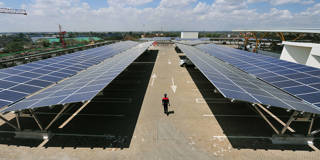The lasting effects of inflation, war, and pandemic policies in 2022 will continue to shape market conditions and generate volatility in 2023 and beyond. For those seeking stable investment returns, health care, education, energy, and China will be the biggest opportunities to watch.
LONDON – Three macro forces will continue to drive volatility in policymaking and financial markets, dominating investors and multinationals’ thinking in the months ahead. They will be watching inflation – and, concomitantly, interest rates; the war in Ukraine and its impact on global energy and food prices; and China’s faltering growth trajectory, notwithstanding the government’s phase-out of its zero-COVID policy. Together, these risks have fueled fears about persistent low growth and possibly even a global recession.
The global outlook is further threatened by headwinds that were undermining the global economy even before the 2020 pandemic. These include the world’s growing population, which has now surpassed eight billion; technological disruption and the prospect of a jobless underclass; and rising inequality, not just in income but also in access to quality education, health care, and employment. Climate change, resource scarcities, and the increasingly urgent energy transition all imply that greater disruptions are imminent, at a time when a growing debt overhang is threatening state-funded social programs around the world.
These are complex long-term problems that will take many years to solve. Fortunately, the opportunities available to generate risk-adjusted returns above the cost of capital are potentially significant enough to overcome many of the adverse macro forces and structural headwinds. Specifically, three broad considerations will shape the investment landscape this year, and probably in the decade to come.
First, technological developments will extend far beyond the social networks and consumer-facing services that have defined the past 15 years. Forthcoming innovations could radically disrupt the provision of public goods such as education and health care, and we are already seeing big breakthroughs in fields such as bioscience and artificial intelligence.
By 2040, health care as we know it might no longer exist. According to the Deloitte Center for Health Solutions, the industry’s focus is shifting from cures to prevention, with technology being leveraged to improve the delivery of care. Cloud-based data platforms and AI analytics, for example, have been used in hospitals to reduce the sepsis mortality rate substantially. With such wide-ranging potential, Global Market Insights expects the digital health-care market to reach $780 billion by 2030, up from $195 billion in 2021. For investors, digital health solutions are a clear avenue of growth and steady returns.
Education technology has also gathered momentum among investors in recent years. According to McKinsey & Company, venture capital funds committed $21 billion to the sector in 2021 alone – a 40-fold increase from 2010. As in health tech, this marked increase in investment flows may signal a growth spurt with staying power.
Second, China will remain an important part of the global growth story and a destination for investment. The International Monetary Fund is forecasting that its economy will grow by 4.4% in 2023, significantly outpacing the average projected 1.1% growth rate across the advanced economies, including the United States, the United Kingdom, and European Union. The fact that Chinese authorities are finally loosening COVID-19 restrictions can only strengthen the country’s growth outlook.
To be sure, with Xi Jinping fully consolidating his power at the 20th National Congress of the Communist Party of China last October, it is reasonable to ask whether China will remain investable over the long term. But even if China’s political trajectory is not ideal, its strong position as a burgeoning technology leader means that it is likely to continue offering attractive opportunities for global investors.
According to a 2021 report by Graham Allison of Harvard University’s Kennedy School of Government, China has already established dominance in 5G and quantum computing, and it is on track to overtake the US in AI, semiconductors, biotech, and green energy over the next decade. These are all promising growth industries that will be pulling in more investment capital (and public-policy support) in the years ahead.
Finally, the world economy is still in the early stages of a transformation that will upend all the leading economies’ energy systems. The UK, France, Japan, Canada, and Germany have formally enshrined 2050 net-zero-emissions commitments into law, while China and even Russia have pledged to achieve carbon neutrality by 2060. There already are considerable investment opportunities not just in sustainable energy production and distribution, but also in ancillary sectors such as transportation, buildings, and other physical infrastructure. These will all be growth industries for years to come.
Moreover, more than one billion people lack access to clean, affordable, and reliable energy, and the world is emitting roughly 50 billion tons of carbon dioxide each year. Both of these problems point to considerable investment opportunities in new, cleaner energy technologies – such as Generation IV nuclear reactors, hydrogen, and batteries – and in climate-mitigation technologies like carbon capture.
Hence, in 2021, Bloomberg Intelligence projected that the pool of global ESG (environmental, social, governance) assets would grow to $50 trillion in 2025, from $35 trillion in 2020. Yes, this scale of investment – and plenty of promotion – led to highly inflated asset values in 2021. But now that markets have undergone a sharp correction, they are back at levels that should be more favorable for new investments.
Consider renewables, which have suffered a contraction and re-rating of price-earnings multiples. These assets should now be very attractive to investors who are seeking to capitalize on the longer-term supply-demand dynamics of the energy transition. Not for nothing, the energy sector now represents roughly 13% of Berkshire Hathaway’s portfolio, putting it third behind technology (44%) and financial services (24%).
Looking ahead, there is good news and bad news. The good news is that policy and regulatory changes, such as the government subsidies and tax breaks in the US Inflation Reduction Act, will further strengthen investment opportunities in many of the new growth industries. And with China finally reopening and inflation showing signs of having peaked, the threat of global recession may be abating.
The bad news is that growth rates overall are still in secular decline, and that inflation may remain sticky at a higher long-term average of 3.27%. That means investors will need to take a long-term view as they assess the most promising opportunities that 2023 has to offer. We may yet emerge from the long period of lackluster economic growth and paltry investment returns. But that outcome is by no means guaranteed.






LONDON – Three macro forces will continue to drive volatility in policymaking and financial markets, dominating investors and multinationals’ thinking in the months ahead. They will be watching inflation – and, concomitantly, interest rates; the war in Ukraine and its impact on global energy and food prices; and China’s faltering growth trajectory, notwithstanding the government’s phase-out of its zero-COVID policy. Together, these risks have fueled fears about persistent low growth and possibly even a global recession.
The global outlook is further threatened by headwinds that were undermining the global economy even before the 2020 pandemic. These include the world’s growing population, which has now surpassed eight billion; technological disruption and the prospect of a jobless underclass; and rising inequality, not just in income but also in access to quality education, health care, and employment. Climate change, resource scarcities, and the increasingly urgent energy transition all imply that greater disruptions are imminent, at a time when a growing debt overhang is threatening state-funded social programs around the world.
These are complex long-term problems that will take many years to solve. Fortunately, the opportunities available to generate risk-adjusted returns above the cost of capital are potentially significant enough to overcome many of the adverse macro forces and structural headwinds. Specifically, three broad considerations will shape the investment landscape this year, and probably in the decade to come.
First, technological developments will extend far beyond the social networks and consumer-facing services that have defined the past 15 years. Forthcoming innovations could radically disrupt the provision of public goods such as education and health care, and we are already seeing big breakthroughs in fields such as bioscience and artificial intelligence.
By 2040, health care as we know it might no longer exist. According to the Deloitte Center for Health Solutions, the industry’s focus is shifting from cures to prevention, with technology being leveraged to improve the delivery of care. Cloud-based data platforms and AI analytics, for example, have been used in hospitals to reduce the sepsis mortality rate substantially. With such wide-ranging potential, Global Market Insights expects the digital health-care market to reach $780 billion by 2030, up from $195 billion in 2021. For investors, digital health solutions are a clear avenue of growth and steady returns.
Education technology has also gathered momentum among investors in recent years. According to McKinsey & Company, venture capital funds committed $21 billion to the sector in 2021 alone – a 40-fold increase from 2010. As in health tech, this marked increase in investment flows may signal a growth spurt with staying power.
SPRING SALE: Save 40% on all new Digital or Digital Plus subscriptions
Subscribe now to gain greater access to Project Syndicate – including every commentary and our entire On Point suite of subscriber-exclusive content – starting at just $49.99.
Subscribe Now
Second, China will remain an important part of the global growth story and a destination for investment. The International Monetary Fund is forecasting that its economy will grow by 4.4% in 2023, significantly outpacing the average projected 1.1% growth rate across the advanced economies, including the United States, the United Kingdom, and European Union. The fact that Chinese authorities are finally loosening COVID-19 restrictions can only strengthen the country’s growth outlook.
To be sure, with Xi Jinping fully consolidating his power at the 20th National Congress of the Communist Party of China last October, it is reasonable to ask whether China will remain investable over the long term. But even if China’s political trajectory is not ideal, its strong position as a burgeoning technology leader means that it is likely to continue offering attractive opportunities for global investors.
According to a 2021 report by Graham Allison of Harvard University’s Kennedy School of Government, China has already established dominance in 5G and quantum computing, and it is on track to overtake the US in AI, semiconductors, biotech, and green energy over the next decade. These are all promising growth industries that will be pulling in more investment capital (and public-policy support) in the years ahead.
Finally, the world economy is still in the early stages of a transformation that will upend all the leading economies’ energy systems. The UK, France, Japan, Canada, and Germany have formally enshrined 2050 net-zero-emissions commitments into law, while China and even Russia have pledged to achieve carbon neutrality by 2060. There already are considerable investment opportunities not just in sustainable energy production and distribution, but also in ancillary sectors such as transportation, buildings, and other physical infrastructure. These will all be growth industries for years to come.
Moreover, more than one billion people lack access to clean, affordable, and reliable energy, and the world is emitting roughly 50 billion tons of carbon dioxide each year. Both of these problems point to considerable investment opportunities in new, cleaner energy technologies – such as Generation IV nuclear reactors, hydrogen, and batteries – and in climate-mitigation technologies like carbon capture.
Hence, in 2021, Bloomberg Intelligence projected that the pool of global ESG (environmental, social, governance) assets would grow to $50 trillion in 2025, from $35 trillion in 2020. Yes, this scale of investment – and plenty of promotion – led to highly inflated asset values in 2021. But now that markets have undergone a sharp correction, they are back at levels that should be more favorable for new investments.
Consider renewables, which have suffered a contraction and re-rating of price-earnings multiples. These assets should now be very attractive to investors who are seeking to capitalize on the longer-term supply-demand dynamics of the energy transition. Not for nothing, the energy sector now represents roughly 13% of Berkshire Hathaway’s portfolio, putting it third behind technology (44%) and financial services (24%).
Looking ahead, there is good news and bad news. The good news is that policy and regulatory changes, such as the government subsidies and tax breaks in the US Inflation Reduction Act, will further strengthen investment opportunities in many of the new growth industries. And with China finally reopening and inflation showing signs of having peaked, the threat of global recession may be abating.
The bad news is that growth rates overall are still in secular decline, and that inflation may remain sticky at a higher long-term average of 3.27%. That means investors will need to take a long-term view as they assess the most promising opportunities that 2023 has to offer. We may yet emerge from the long period of lackluster economic growth and paltry investment returns. But that outcome is by no means guaranteed.